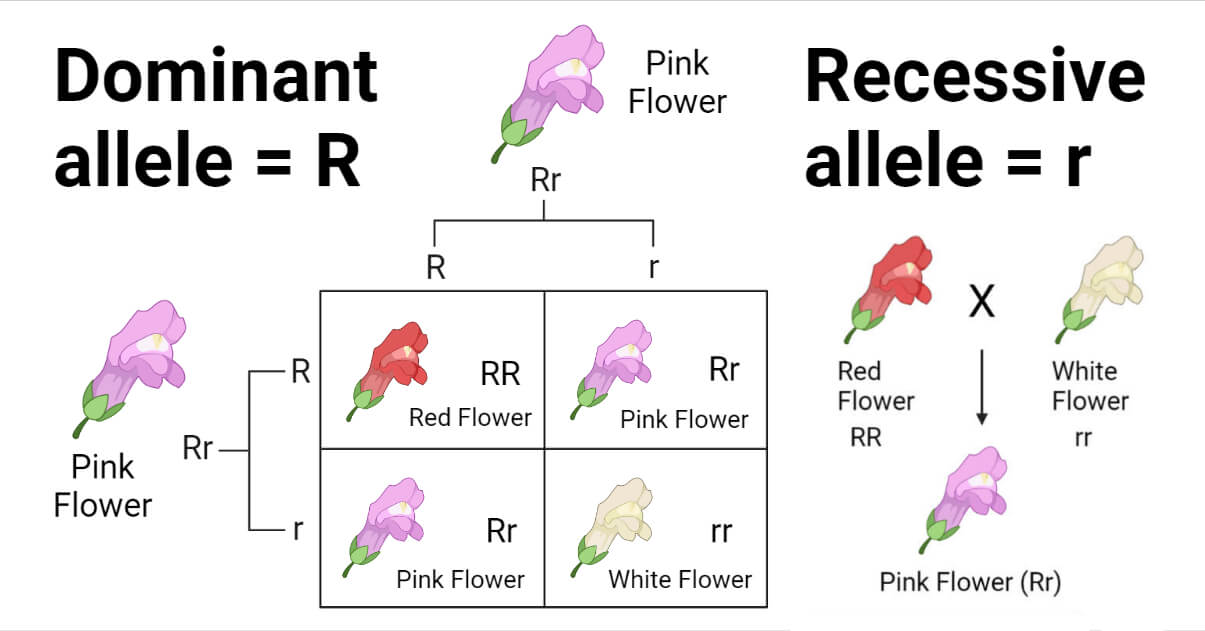There are 23 pairs of chromosomes in each human cell and hundreds of thousands of distinct genes on each chromosome.
An individual inherits two versions of each gene, known as alleles, from each parent.
An allele is a chromosomal pair of genes that controls a heritable trait.
Alleles can be categorized as dominant or recessive, where dominant refers to the visible trait, and recessive refers to the one that is not visible morphologically.
Dominant alleles are generally denoted by capital letters, whereas recessive alleles are denoted by lowercase letters.

A homozygous trait has either two capital letters or two lowercase letters.
Heterozygous traits are those that have alternating letters. The capital letter will always come first in heterozygous alleles.
For example:
If the dominant gene for brown eyes is “B” and the recessive gene is “b” for blue eyes, then the alleles for the dominant trait can be either “BB” or “Bb” while “bb” is for a recessive trait.
A person will exhibit the dominant trait if they have a heterozygous set of alleles, i.e., BB or Bb.
In the case of a recessive trait, the alleles of the trait-causing gene are the same, and both recessive alleles must be present to express the trait (bb).
Having the same two copies of an allele is a homozygous condition.
When only one copy is present, a recessive allele does not result in any trait.
On the other hand, a dominant trait can also be expressed when one of the two alleles is present.
Many genes interact in the production of one trait, such as hair color, eye color, size, shape, and so forth, and one gene (in conjunction with others) often influences many traits.
Interesting Science Videos
Dominant and Recessive Traits in Plants
| Name of Plant | Dominant Trait | Recessive Trait |
| Nettle | Serrated leaves | Smooth margined leaves |
| Sunflower | Branched habit | Unbranched habit |
| Cotton | Colored lint | White lint |
| Maize | Round starchy kernel | Wrinkled sugary kernel |
| Snapdragon | Red flower | Non-red flower |
| Barley | Beardlessness | Beardness |
| Wheat | Susceptibility to rust | Immunity to rust |
| Tomato | Two-celled fruits | Many-celled fruit |
Dominant and Recessive Traits in Animals
| Name of Animal | Body character | Dominant Trait | Recessive Trait |
| Cat | Skin color | Tabby | Black or Blue |
| Cat | Length of hair | Short hair | Long Hair |
| Dog | Skin color | Grey | Black |
| Dog | Tail | Stumpy | Normal |
| Cattle | Face Color | White | Colored |
| Cattle | Horn | Poled or Hornless | Horned |
| Horse | Skin color | Black | Red |
| Horse | Movement | Trotting | Pacing |
| Sheep | Hair/Wool/Fleece | White | Black |
| Swine | Skin color | Black | Red |
| Swine | Hoof | Uncleft | Normal |
| Salamander | Body color | Dark | light |
| Drosophila | Eye color | Red | White |
| Drosophila | Wings | Flat and yellow | Curled and White |
| Drosophila | Body color | Grey | Black |
| Land snail | Shape of shell | Unbanded shell | Banded shell |
Dominant and Recessive Traits in Humans
| Traits | Dominant | Recessive |
| Baldness (In male) | Presence | Absence |
| Body Hair | Abundant | Little |
| Bend Pinkie Finger | Able to bend | Not able to bend |
| Cleft in Chin | Presence | Absence |
| Crossing of Thumbs | Left thumb over right thumb | Right thumb over left thumb |
| Dimples | Presence | Absence |
| Earlobes | Free earlobes | Attached earlobes |
| Freckles | Presence | Absence |
| Iris | Brown | Blue |
| Hairline | Widow’s peak | Straight |
| Hair Color | Dark | Light |
| Handedness | Right handedness | Left handedness |
| Hitchhiker’s Thumbs | Absence | Presence |
| Lips width | Broad lips | Thin lips |
| Mongolian Eye Fold | Presence | Absence |
| Nose Shape | Roman nose (bump) | Straight |
| Nose Width | Broad nose | Narrow nose |
| Rh factor in Blood | Rh factor positive (+) | Rh factor negative (-) |
| Toe Length | Second toe longer than first toe | First toe longer than second toe |
| Tongue Rolling | Ability to roll tongue | Inability to roll tongue |
| Webbed Fingers | Presence | Absence |
References
- Altenburg E. (1965). The Relation of Genes to Traits. In Genetics (Revised Edition). Holt, Rinehart and Winston, Inc., pp. 16
- Biologywise. (2022). Dominant and Recessive Traits in Humans.
- Accessed from: https://biologywise.com/dominant-recessive-traits-in-humans. Accessed on: 13.09.2022
- Classroom Partners. (2022). Punnett Square.
- Accessed from: https://pressbooks.umn.edu/classroompartners/chapter/punnett-squares/. Accessed on: 13.09.2022
- National Human Genome Research Institute (NIH). (2022). Recessive Traits and Alleles. Accessed from: https://www.genome.gov/genetics-glossary/Recessive-Traits-Alleles. Accesed on: 13.09.2022.
- Verma P.S. and Agarwal V.K. (2005). Mendel and His work. In Cell Biology, Genetics, Molecular Biology, Evolution and Ecology. Multi-color Edition. S. Chand & Company Ltd. Ram Nagar, New Delhi, pg 29-30
